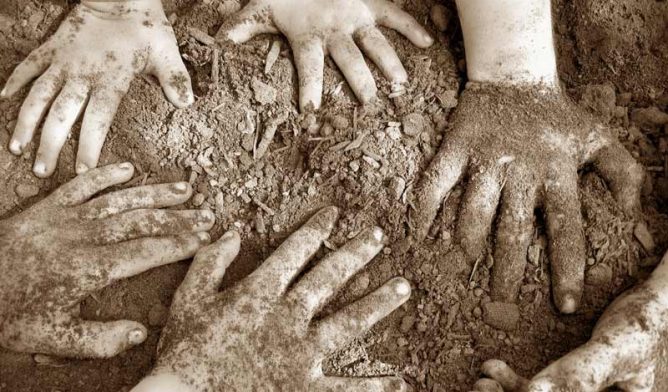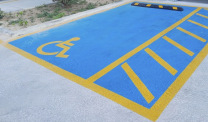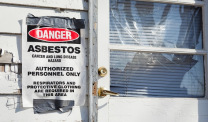Children and Asbestos: What Every Parent Needs to Know
Awareness & ResearchWritten by Lorraine Kember | Edited By Walter Pacheco

In an age when almost anything seems possible, it’s mind-boggling that we can’t find a solution to the problem of asbestos in our environment.
Responsible for thousands of deaths around the world, this issue doesn’t seem to have an end in sight. The next victims of asbestos exposure could be children who are not aware of the dangers and are not armed with the knowledge of how to protect themselves.
Children will jump, skip and slide on any surface. They’ll pick up rocks, pebbles and other small pieces of material to play with. Kids will make mud pies out of soil and turn old sheds into clubhouses, regardless of their state of disrepair.
They’re often unaware of the danger that could exist in their neighborhood — or even their own backyard.
But we know. And the sooner we educate our children about the dangers of asbestos, the better.
Unfortunately, the risk of asbestos exposure is not going away. In fact, it will worsen as time goes on.
Any home built before 1980 is likely to contain deadly asbestos, predominantly in walls and roofing constructed with asbestos sheeting — a matrix of cement and asbestos fibers.
As these asbestos sheets age, the cement used to hold the asbestos fibers in place deteriorates. When this occurs, a deadly mix of cement dust and asbestos fibers are carried with the wind into the environment.
Breathing in this dust can cause mesothelioma and other asbestos-related diseases up to 50 years from the initial exposure.
Wittenoom’s History Demonstrates Asbestos Threat
The tragic consequence of children being exposed to asbestos is demonstrated in the history of Wittenoom, a former asbestos mining town in the Pilbara area of Western Australia.
During mining operations spanning 23 years, up to 9,000 children — including 2,000 under the age of 15 — are believed to have been exposed to asbestos, predominantly through asbestos tailings spread over backyards, playing fields and most public areas.
Asbestos mining operations in Wittenoom ended in 1966, but the tragic aftermath of the carcinogen was just beginning. When the children left the town, the asbestos fibers they inhaled went with them.
Many grew to adulthood and led seemingly healthy lives for up to 50 years before the sudden onset of shortness of breath signaled their first known symptom of mesothelioma.
To date, more than 2,000 workers and residents of Wittenoom have died from asbestos-related diseases.
Sadly, my husband Brian is among them. Growing up in Wittenoom, he enjoyed excellent health for 45 years after leaving the town.
At 52, he began to experience shortness of breath and was subsequently diagnosed with pleural mesothelioma. He died two years later.
Though the evidence is clear, there is much complacency in regard to asbestos and the health hazard it poses to us all.
Out of sight should not be out of mind when it comes to asbestos. It is a hidden danger that lurks in aging homes and buildings around the world, including schools.
Why Children Are at Higher Risk for Mesothelioma
Children’s lungs and respiratory systems are still in the developing stages.
Their lungs are smaller and have a higher surface area to volume ration than the lungs of adults. Children also breathe at a faster rate, meaning they can inhale more asbestos fibers with every breath.
Children are also susceptible to exposure through sticking their fingers in their mouths. If they have previously come into contact with asbestos particles, they could accidentally ingest the fibers.
Ingested asbestos fibers can cause peritoneal mesothelioma.
How to Protect Your Child from Asbestos Exposure
The only protection we have against asbestos is knowledge, vigilance and care for our children.
What to Do to Protect Children from Asbestos
- Tell them what asbestos is, where it comes from and where it is commonly found in houses and other buildings.
- Explain to them that it is safe for people to live and work in these older establishments, as long as the asbestos-containing materials are in good condition and well maintained.
- Advise them that damage to these materials — caused by weather, fire or human intervention — causes microscopic asbestos fibers to be released into the air they breathe.
- Visit your child’s school, ask the administration if asbestos-containing building materials are present and what has been done to protect the children.
- Be aware of what you are buying for your children. Asbestos has been found in crayons and more recently been found in children’s makeup.
- Be proactive. Talk to your friends and neighbors about asbestos and what they can do to protect their children and themselves from harm.
- Encourage your children to let you know if they hear of someone attempting asbestos removal from an older home, instead of employing an accredited asbestos abatement company.
What Not to Let Your Children Do
- Do not let your children play in or around abandoned homes or sheds that may contain asbestos.
- Do not let them play on building sites or areas where older homes have been demolished.
- Advise them not to climb over, sit on or pick up any broken pieces of fibro asbestos sheeting they might find laying around.
- Do not let them drink out of old water fountains. The pipes may contain asbestos that can leak into the water.






